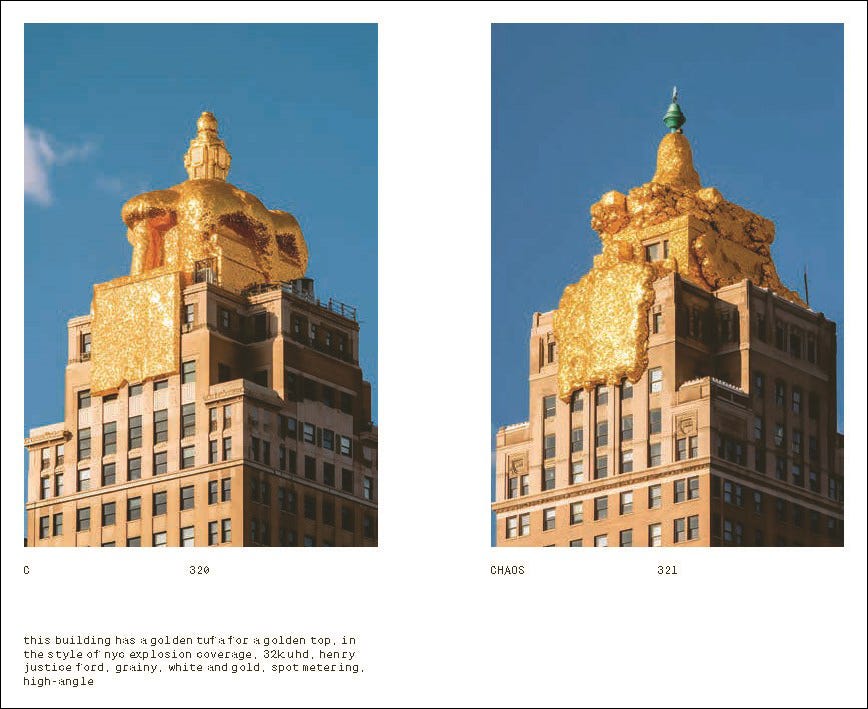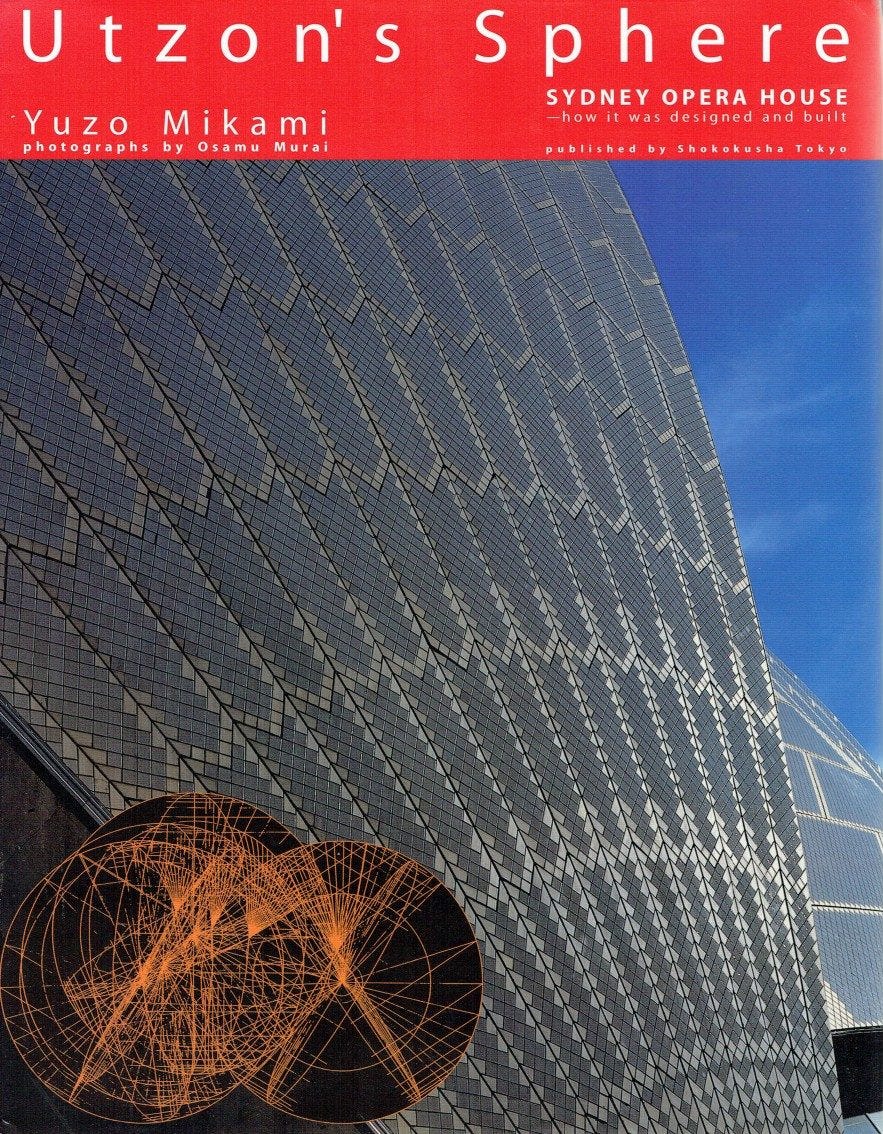Welcome to the new A Weekly Dose of Architecture Books newsletter. After shuttering my long-running blog last week and transitioning my ongoing efforts to Substack, from now on my reviews of architecture books will be here, in the newsletter. Following the “book of the week” review are new releases, book news, and a couple books from the archives; these elements comprise the format of the new newsletter. This newsletter is free but welcomes voluntary paid subscriptions — details at bottom.
Architecture Book of the Week:
Hey Computer! : Icons of Architecture, Rebuilt by AI by Floyd E. Schulze (with an essay by Georg Vrachliotis), published by Jovis (Amazon / Bookshop)
Like many architects, or so I imagine, I’ve greeted the widespread release of AI tools in recent years with a healthy dose of skepticism. I examined ChatGPT on my blog last year, comparing its reviews of architecture books to my own, but I’m guessing most architects are interested less in AI that outputs text than they are in AI that churns out floor plans from particular parameters or quickly generates imagery from text prompts. These sorts of AI tools — space planning and conceptual renderings — are alternatively making architects excited and uneasy: excited by the unexpected output, ease-of-use, and time-saving features; uneasy by the (distant) prospect that AI will make architects obsolete. I like to think of AI as yet another tool that architects can use (or not) as they go about their work, incorporating it as they see fit; there are so many parts in the architectural process that cannot be addressed by AI that it’s premature to consider the technology simply as a threat or a savior. Nevertheless, it’s impossible to ignore AI, given the many articles focused on it and the thousands of images constantly being created by DALL-E, Midjourney, Stable Diffusion, and other text-to-image models.
While books about AI and architecture in relation to theory and practice have been released in recent years — most notably Neil Leach's Architecture in the Age of Artificial Intelligence: An Introduction to AI for Architects and Phil Bernstein’s Machine Learning: Architecture in the age of Artificial Intelligence, two books I have not read — Hey Computer! appears to be the first that looks exclusively at images of architecture as filtered through AI. Yet, instead of AI being used to create moody, slightly surreal environments or to study the potentials of large-scale 3D printing, graphic designer Floyd E. Schulze sicced AI on familiar buildings, creating wholly unexpected imagery that captures the technology’s benefits but also its limitations. Take the spread above, a 50-step procedure from Stable Diffusion that is based on Notre Dame de Haut, aka the Chapel at Ronchamp. Does it resemble Le Corbusier’s famous design? Hardly. I would even be hard-pressed to describe the image’s roots without the caption. But would an architect have come up with a similar image, whatever the parameters? I can’t help but think of the infinite monkey theorem, but if an architect can do what a computer can — or vice-versa — is besides the point. I prefer to wonder if the image is appealing in any way, or what it reveals about how AI understands architecture through images. As a scaleless sculpture, the image is mildly interesting, feeling contemporaneous with Ronchamp; but considering it as actual physical construction…its intersections, insertions, overlaps, and cantilevers boggle the mind — and it’s far from the most mind-boggling image in the book!
Schulze’s compact book (approx. 4x7”) features hundreds of AI-generated images in three chapters: Buildings, Chaos, and Dreams. The bulk, like Ronchamp, are in the first, always captioned with the text prompts he used and most resembling inferior versions of the buildings they are based on. Some of the most convincing images combine influences, such as the versions of Le Corbusier’s Villa Savoye “in the style of Bernd and Hilla Becher”: a modernist-industrial mashup worthy of preservation if it were built a century ago. The Chaos chapter features “various glitches and hiccups generated by [Schulze’s] prompts,” veering from the “surprising” to the “disturbing.” Examples include the cover image, Jørn Utzon’s Sydney Opera House “wrapped in gold foil, in the style of Christo and Jeanne-Claude,” and the above spread, in which the gilded roof of a building akin to Cass Gilbert’s New York Life Building bubbles and drips over its parapets. These and many other images in the book combine the familiar and unexpected in ways that are, more than anything, humorous. In fact, I can’t think of an architecture book that made me smile as much as I did while flipping through Hey Computer!
Architecture Books Released This Week:
(In the United States, a curated list)
Chicagoland Dream Houses : How a Mid-Century Architecture Competition Reimagined the American Home by Siobhan Moroney, published by University of Illinois Press (Amazon / Bookshop) — A historical look at the 1945 Chicagoland Prize Homes competition, an "overlooked chapter in Chicago and architectural history." (Having grown up in the Chicago suburbs and lived in the city after college, I never knew about it so can attest to the "overlooked" nature of the competition.)
Horror in Architecture: The Reanimated Edition by Joshua Comaroff and Ong Ker-Shing, published by University of Minnesota Press (Amazon / Bookshop) — A new edition of the “unflinching look at how horror genre tropes manifest in the built environment,” first published in 2013 and reviewed on my blog in 2014.
Parklife Hideaways : Cottages and Cabins in North American Parklands edited by gestalten and Parks Project, published by gestalten (Amazon / Bookshop) — Though not restricted to national parks per se, this book surveys cabins, A-frames, and other structures in the National Park Service rustic style: buildings that strongly harmonize with the natural environment.
Sustainable Architecture & Design 2023 / 2024 edited by Andrea Herold and Tina Kammer, published by Av Edition (Amazon) — A collection of fifty commendable projects exhibiting circular processes, biodiversity, self-sufficiency, and other concerns in contemporary design and construction; edited by the founders of the InteriorPark. sustainability consultancy.
Full disclosure: As an Amazon Associate, AbeBooks Affiliate, and Bookshop.org Affiliate, I earn commissions from qualifying purchases made via any relevant links above and below.
Architecture Book News:
Jade Kake and Jeremy Hansen speak with Deidre Brown at Metro about Rewi: Āta haere, kia tere, their new book featuring 35 interviews with people who knew Māori architect Rewi Thompson, who died in 2016 at the age of 63.
Herbert Simms: An Architect for the People by Lindie Naughton is, Andrew Lynch writes at Business Post, a “rather dense” and “authoritative” narrative on the architect who oversaw the construction of around 17,000 public homes in Dublin in the 1930s and 40s; it still “leaves more personal questions unanswered.”
The Architect’s Newspaper presents “16 architecture and design books to look out for in 2024,” including titles by Aaron Betsky, Jeanne Gang, and Michelangelo Sabatino.
Creative Boom takes a peek inside Concrete Hong Kong, a new book by Zupagrafika that "celebrates the architecture of Hong Kong public housing in the 1950s-1980s" and comes with folded paper models of a few housing estates.
From the Archives:
On this week in 2012, I reviewed Wonderland Manual for Emerging Architects, describing it as “valuable for architects who not only want to set themselves apart from their peers but want to do it responsibly and work towards dealing with areas of crisis that architects would do well not to ignore.” A second edition was released in 2018.
Apropos of this week’s “Architecture Book of the Week,” which features Jørn Utzon’s Sydney Opera House on its cover and manipulations of it across a few of its pages, Yuzo Mikami's Utzon's Sphere: Sydney Opera House – How It Was Designed and Built (Shokokusha Publishing, 2001) is an enlightening, if hard-to-find book on the design and engineering of the iconic building. Mikami worked in Utzon’s office in Denmark from 1958 to 1961 and in Ove Arup’s office from 1962 to 1967 (the competition winner was named in 1957, Utzon resigned in 1966, and the building opened in 1973), so he had first-hand knowledge of Utzon’s geometric explorations and Arup’s attempts to turn them into concrete. The book is abundantly illustrated with drawings, both architectural and engineering and including a few from the famous “Red Book” and “Yellow Book,” and photographs taken by Osamu Murai in 1999. Coincidentally, there was also a “Gold Book,” but it did not involve any gold foil!
Thank you for subscribing to A Weekly Dose of Architecture Books. If you have any comments or questions, or if you have your own book that you want to see in this newsletter, please respond to this email, or comment below if you’re reading this online. All content is freely available, but paid subscriptions that enable this newsletter to continue are welcome — thank you!
— John Hill









